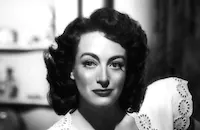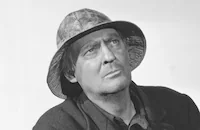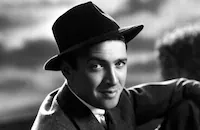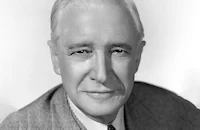The Gorgeous Hussy

Brief Synopsis
Cast & Crew
Clarence Brown
Joan Crawford
Robert Taylor
Lionel Barrymore
Franchot Tone Eaton
Melvyn Douglas
Film Details
Technical Specs

Synopsis
In 1823 Washington, Major O'Neal and his daughter Margaret run an inn that is frequented by politicians. Peggy's outspoken and astute opinions have earned the admiration of men such as Andrew Jackson and Daniel Webster. Virginia senator John Randolph, with whom Peggy is secretly in love, seems only to regard her as a child. When new inn resident "Bow" Timberlake refers to Peggy as a "tavern girl," however, John slaps him. Bow soon falls in love with Peggy himself and proposes, but she refuses, then goes to John's room one night to confess her love for him. He sends her away, thinking that she is too young and does not really mean it, but begins to have a change of heart. When he finally realizes that they are both in love, however, he learns from Bow that Peggy has finally consented to marry him. Peggy again talks to John about their future, but John again rejects her, thinking that the younger Bow would be a more suitable husband. Because he is an officer on the U.S.S. Constitution , Bow must leave for a three month tour of duty shortly after their wedding. When the Constitution returns to Washington, Peggy learns that Bow has died. In 1828, Jackson is elected president amid a campaign of mud slinging aimed at his beloved Rachel, whom he inadvertently married before her divorce from her first husband was final. Soon after the election, Rachel dies after asking Peggy to look after Jackson. Peggy then becomes the president's official hostess and confidant, causing many of the Washington political wives to gossip and snub her. At the same time, Jackson comes under political fire from Southerners such as Randolph, who feels he has turned against them by his stand on state rights. At a ball, Peggy is excited to see John after his five-year absence from Washington and asks him to dance with her before dinner. When her childhood friend, "Rowdy" Dow, wants to fight Southern Senator John C. Calhoun because of an insulting remark about Peggy, however, she interrupts and asks him to dance instead. Seeing Rowdy and Peggy dancing, John returns home, but is followed by Peggy, who once again professes her love. This time, John admits his own love and the two plan to marry. Soon after telling Jackson what has happened, however, Peggy realizes that differing political views will never allow her and John to be happy, and they part. A short time later, Secretary of War John Eaton, who has loved Peggy for years, proposes. She is fond of him, and believes, like Jackson, that marriage will bring her respectability. A year later, Rowdy comes to visit and tells Peggy that John Randolph has been shot and is near death. She asks Rowdy to take her to see her John, who was shot by Sunderland, a Southerner trying to prevent him from revealing to Jackson a proposed violent rebellion. John dies contentedly after Peggy's visit. On the way back to Washington, Peggy and Rowdy's coach is accosted by Sunderland, who demands safe passage to Washington in exchange for not revealing that he has seen them. Rowdy throws him out, but soon Jackson's cabinet members and their wives come to him to demand that Peggy be sent away from Washington. When Peggy arrives at the meeting, Jackson lies by saying she was sent to see John Randolph by him and that Rowdy was asked by John Eaton to accompany her. Jackson then demands the resignation of his entire cabinet, except for John. Finally, Peggy, who knows that even Jackson's kind lie will not lead to her acceptance in Washington, asks him to send John as the special envoy to Spain where she knows that they will find contentment.

Director

Clarence Brown
Cast

Joan Crawford

Robert Taylor

Lionel Barrymore
Franchot Tone Eaton

Melvyn Douglas

James Stewart

Alison Skipworth

Beulah Bondi

Louis Calhern

Melville Cooper

Sidney Toler
Gene Lockhart O'neal
Clara Blandick

Frank Conroy
Nydia Westman
Charles Trowbridge Van Buren
Willard Robertson
Ruby De Remer
Betty Blythe
Zeffie Tilbury

Edith Atwater
Phoebe Foster

Frank Conroy

Louise Beavers
Greta Meyer
Fred "snowflake" Toones

Lee Phelps
George Reed
Bert Roach
Else Janssen
Oscar Apfel
Richard Powell
Franklin Parker
Lee Harvey
Syd Saylor
Wade Boteler
Hooper Atchley
Morgan Wallace
William Stack
Harry C. Bradley

Ward Bond
Sam Mcdaniel

Samuel S. Hinds
Crew
Adrian
Stephen Morehouse Avery
Clarence Brown
Charles Dorian
George Folsey
Cedric Gibbons
William A. Horning
Joseph L. Mankiewicz
Ainsworth Morgan
Val Raset
Blanche Sewell
Douglas Shearer
Herbert Stothart
Edwin B. Willis

Photo Collections
Videos
Movie Clip


Film Details
Technical Specs

Award Nominations
Best Cinematography
Best Supporting Actress
Articles
The Gorgeous Hussy
Recently married to New York actor and upper-class intellectual Franchot Tone, Crawford had acquired intellectual pretensions of her own. Essaying an historical character may have been part of that. The Gorgeous Hussy was based on a popular historical novel about Peggy O'Neal Eaton, a sassy innkeeper's daughter who gained political power in the 1830s because of her friendship with President Andrew Jackson, but was ostracized by Washington society. MGM executive David Selznick tried to talk Crawford out of tackling the role of Peggy Eaton by telling her "you can't do a costume picture, you're too modern." When she would not be dissuaded, Selznick decided to surround her with not one, but five strong leading men, and assigned producing duties to Joseph L. Mankiewicz, who had recently been working with Crawford and understood her strengths and weaknesses.
The Gorgeous Hussy certainly looked great, with Adrian's lavish period costumes, George Folsey's stunning cinematography, and Cedric Gibbons' elegant art direction. And the men surrounding Crawford ranged from adequate to magnificent. As Peggy's first husband, Robert Taylor looked handsome, which was all that was required for his brief role. Newcomer James Stewart, conspicuously out of place in the period wardrobe and silly sideburns, had the grace not to look embarrassed. Melvyn Douglas was more at ease in the costumes, and gave some complexity to his character. Franchot Tone, Crawford's husband at the time and playing her second husband in the film, was miserable with his nothing role, plus being reduced to his wife's coat-holder hit a little too close to home. Working together in The Gorgeous Hussy definitely put a strain on the marriage, especially when Tone began drinking and arriving late on the set, sins that the always professional Crawford would not tolerate.
The film's greatest asset, however, was Lionel Barrymore's splendid performance as Andrew Jackson. Despite the elaborate makeup which gave him a startling resemblance to the real Jackson, Barrymore's talent and humanity shone through. The actor was already suffering from the illness that would cripple him ¿ a form of arthritis. He could barely walk anymore, but he could stand, and when the camera was rolling, he would push through the pain and do what was required. The part offered Barrymore the opportunity to display a broad emotional range, from thundering oratory to overwhelming grief at the loss of his beloved wife. The latter hit too close to home -- Barrymore's own wife was terminally ill with tuberculosis. She died on Christmas Eve of 1936.
In the end, though, not even terrific acting by a stellar cast could save The Gorgeous Hussy. Although the critics praised some of the performances (particularly Barrymore's, and even Crawford's), most of them found the film dull and stodgy. Frank Nugent in the New York Times sneered, "Miss Crawford's Peggy is a maligned Anne of Green Gables, a persecuted Pollyanna, a dismayed Dolly Dimple." The consensus seemed to be, "gorgeous, yes, but not enough hussy." The problem was that although the real Peggy, as portrayed in the book, was fascinating and complex, censorship of the era would not allow the filmmakers to deal with her alleged affairs and improprieties in a frank manner, so audiences couldn't understand what all the fuss was about. And MGM executives' fears were also confirmed: moviegoers wanted Crawford to be contemporary, and would not accept her in period costume, no matter how glamorous. Ever attuned to her public, Crawford never made that mistake again.
Director: Clarence Brown
Producer: Joseph L. Mankiewicz
Screenplay: Ainsworth Morgan & Stephen Morehouse Avery, based on the book by Samuel Hopkins Adams
Cinematography: George Folsey
Editor: Blanche Sewell
Costume Design: Adrian
Art Direction: Cedric Gibbons
Music: Herbert Stothart
Principal Cast: Joan Crawford (Peggy O'Neal Eaton), Robert Taylor (Bow Timberlake), Lionel Barrymore (Andrew Jackson), Melvyn Douglas (John Randolph), James Stewart ("Rowdy" Dow), Franchot Tone (John Eaton), Beulah Bondi (Rachel Jackson), Gene Lockhart (Major O'Neal).
BW-104m. Closed captioning.
by Margarita Landazuri

The Gorgeous Hussy
Quotes
Trivia
This was the first film Joan Crawford and Franchot Tone made together after their marriage in 1935.
Notes
According to a news item in Hollywood Reporter, Jean Harlow was to have appeared in the title role of this film. According to contemporary news items, RKO originally planned to film Samuel Hopkins Adams' novel, starring Katharine Hepburn, in 1934. When M-G-M obtained the rights to the novel in 1935, it was announced that Jean Harlow would star and Brian Aherne would play one of the male leads. Information contained in the file on the film in the MPAA/PCA Collection in the AMPAS library, notes that the Hays Office raised serious objections about the profanity used by Andrew Jackson throughout the original script. All instances of the character saying "damn" or "hell" were subsequently removed from the script. Some reviews noted that although the film was loosely based on real characters and incidents, many historical inaccuracies were present. Modern sources note that Bow Timberlake actually committed suicide and that John Eaton was forced to resign from Jackson's cabinet. Although Joan Crawford and Franchot Tone had acted together previously on the screen, this was their first joint film appearence subsequent to their 1935 marriage, a fact prominently mentioned in studio publicity for the picture. Beulah Bondi received an Academy Award nomination as Best Supporting Actress for her role as Rachel Jackson. Modern sources credit Henry Grace with set decoration.

Miscellaneous Notes
Released in United States 1936
Released in United States on Video June 24, 1992
Released in United States 1936
Released in United States on Video June 24, 1992













